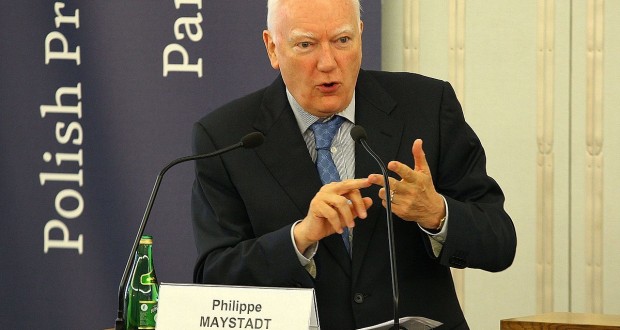Among the numerous and prestigious contributions of our Special Review “Euroland at a crossroads“, we have the honour of counting one of the last texts by Philippe Maystadt, former Belgian minister, who unfortunately passed away on December 7th last year, during the preparation of the Review. We have wished to pay tribute to this great European by dedicating the entire publication to his memory, and by making public his contribution in full*. This interview is a moment of cleverness and clarity that we invite you to experiment.
* The complete Review is otherwise on pay (5 euros) on Anticipolis
———–
In spite of his poor health, Philippe Maystadt agreed to receive us at his home for this interview held before his death on 7th December 2017. He reviewed and updated this text on 3rd December. We are extremely grateful to him for doing this.
Interview by Robert Polet and Godelieve Ugeux
LEAP : Our citizens have become used to their new currency, the euro, but now they no longer understand the purposes of this currency. Why did we embark on this adventure of the euro, whose vulnerability was revealed by the crisis of 2008?
Ph. Maystadt : The Economic and Monetary Union (EMU) was first and foremost a political project.
In the aftermath of the reunification of Germany, the aim was to strengthen European integration and firmly anchor this country to Europe. According to the famous phrase of Thomas Mann, “not a German Europe but a European Germany”. To ask Germany to give up the Deutsche Mark, the strongest and most stable currency, and accept a common currency, was to ask for a particularly strong sign of its European will. The German people remained traumatised by their historical experience of a ‘hyperinflation’ back in the 1920s. Between 1918 and 1923, the value of the same Goldmark in Papermarks (banknotes) increased from 1 to 1000 billion!
It is precisely this political integration dimension that the British government understood so well, which is why it first tried to sink the project and then decided not to be part of it.
LEAP : Besides this political vision, were there economic considerations, too?
Ph. M. : Of course. The single currency was seen as the natural extension of the single market. In this market, it was clear that transactions would be quicker and price comparisons easier with one currency. People were fed up with the complications and costs of foreign exchange, which, according to the Commission, represented half a percent of GDP[1]. Also, there would be no more risks and costs resulting from exchange rate volatility – it would no longer be necessary to pay more in order to insure against the risk of currency devaluation of countries which were major trading partners. Those with a short memory have forgotten the serious difficulties that Belgian companies sometimes encountered following repeated devaluations of the French franc or the Italian lira. Moreover, the changeover to the single currency looked like the only way out of the famous ‘incompatibility triangle’[2].
It was not possible to have freedom of capital movement, stability of exchange rates and autonomy of national monetary policies all at the same time. If we wanted to keep the third element, it was necessary either to give up freedom of capital movement and to re-establish exchange controls or accept the volatility of exchange rates and frequent parity changes within the EMS (European monetary system)[3].
With the Single Act[4] of 1987, Europe opted for the free movement of goods, services and capital. At the same time, economic leaders were keen on the stability of exchange rates to promote trade and investment. Indeed, economic analysis had highlighted the overall negative impact of currency turbulence on growth:
(a) Export losses of countries whose currency’s value goes up are never fully offset by export gains of countries whose currencies go down.
(b) Devaluation has an inflationary effect in the country undergoing it and the monetary authorities are forced to pursue a more restrictive policy to avoid excessive price swings.
(c) All surveys show that currency fluctuations undermine the confidence of economic agents.
Therefore, if the first two elements were to be chosen, namely freedom of capital movement and stability of exchange rates, it was necessary to give up the third[5]. It was on the basis of this reasoning that the Maastricht Treaty, ratified 25 years ago and establishing the Economic and Monetary Union, was negotiated. Created in 1992, the EMU would give birth to the euro, a common currency, only ten years later.
Today, 340 million Europeans living in 19 Member States have the euro as their common currency. Their standard of living is no longer at the mercy of the high inflation and volatility of the exchange rates that marked the 1970s and 1980s. Since the introduction of the euro, inflation has generally remained below 2%. Citizens no longer have to pay heavy foreign exchange fees when they go to another euro area country. For businesses, the single currency has allowed them to save a lot of time and money.
LEAP : How did the 2008 crisis disrupt the EMU and highlight its weaknesses?
Ph. M. : The consequences of the global financial crisis that blew up in 2008 – in particular the sovereign debt crisis (of which Greece is only an extreme case and, in many respects, a very specific one) – highlighted the fundamental weakness of a construction in which monetary policy became unified while economic policies remained national and often divergent.
Undoubtedly, there have been some advances since the crisis started:
• The European Stability Mechanism[6]
. The Budget Pact[7]
. The Macroeconomic Imbalance Procedure[8]
. The Banking Union[9]
Largely, these have already corrected this fundamental weakness, but they are not enough.
LEAP : What does the EMU need to make it a successful union at the service of the economy and citizens of the eurozone?
Ph. M. : Several reforms are needed to give the eurozone the stability and the means for a successful management of the Economic and Monetary Union.
Firstly, a eurozone budget:
The experience of other monetary unions shows that, even if the degree of centralisation of instruments and the modalities of financial solidarity can vary, no monetary union can survive without a common budget or, using Herman Van Rompuy’s more prudent terms, without a ‘fiscal capacity’ to help the participating countries absorb asymmetric shocks i.e. economic shocks that hit one or more states harder than the others in the zone. The creation of such a mechanism is all the more necessary because other corrective mechanisms operate less in the eurozone than, for example, in the United States. The mobility of workers is much lower, tensions in the financial markets quickly provoke fragmentation, aggravating the difficulties of countries in crisis and structural rigidities, sometimes regulatory, also hinder adjustment by prices. Thus, despite decreasing demand, some prices are not falling as fast as in the United States. This is true for many services; real estate agencies, in particular, but especially the pricing of regulated professions – notaries, bailiffs, taxis, etc. Moreover, in comparison with the United States, Europe is also experiencing relative wage rigidity. I do not, however, recommend adjustment by a generalised fall in wages because, apart from the individual difficulties that this entails, we have seen that it has a rapid negative effect on global demand. In the case of Greece, the IMF admitted to have underestimated the magnitude of the negative multiplier.
Therefore, we need a eurozone budget to mitigate the budgetary and social costs of adjustment for countries which are hit harder than others. This budget would work according to rules established in advance. It would intervene in favour of countries experiencing a GDP decrease and/or an increase in unemployment significantly higher than the average of the eurozone. Its intervention would also be temporary (for example, the taking over for a year of a substantial part of the additional unemployment expenses[10]. and it would only intervene if the countries implemented the specific recommendations given to them by the ‘European Semester’.
LEAP: What is needed for more democratic management within this semester?
Ph. M.: Every year, the Commission carries out a detailed analysis of the economic and budgetary reform programmes of each Member State and sends them recommendations for the next 12 to 18 months. The European Council examines these recommendations and approves them. Member States thus receive political guidance before finalising their budget proposals for the following year. As acknowledged by Jean-Claude Juncker, whilst the national leaders are responsible for implementing the reforms advocated at European level, ‘what is lacking is the appropriation by the national parliaments’. Therefore, it is essential to involve the national parliaments in the early stages of the procedure in a genuine dialogue between the Commission and each national parliament.
LEAP: These national parliaments – or even regional parliaments in countries with a federal structure such as Belgium and Germany – are they ready to play this European role?
Ph. M.: Yes, I think they are. These are national issues though. In Belgium, for example, the Commission regularly comes back to the idea of putting an end to automatic wage indexation. Before finalising its recommendations, a dialogue with the Belgian parliament would show that, in normal circumstances, this is not necessarily a more inflationary system than any others would be. Conversely, Belgian members of parliament who participate in this dialogue would better understand the risks automatic indexing can lead to in times of high inflation. This could lead to reforms, as in the case of Luxembourg, the only country which has an automatic indexing mechanism with a safeguard against high inflation (one indexation per year only).
As for regional parliaments, they cannot be bypassed in matters for which they have responsibility. In Germany or Belgium, for example, in the field of education, if the Commission wanted to make specific recommendations, it could not ignore the Länder or Communities who have authority over such matters.
LEAP: Let’s go back to this eurozone budget: How could we make it sustainable?
Ph. M.: Several options are possible, but they all require adjustments.
1. By taking a small percentage of corporate taxes. But this implies that we first harmonise the tax base.
2. Or, as suggested by the German and French Ministers of Finance, by taking part of the income of the tax on financial transactions. But this assumes that this is applied, not to 10 states (as currently discussed), but all 19 countries of the eurozone.
In the meantime, in the case of a failure, national contributions should be used, calculated according to the GDP of each Member State. What should be the amount of this budget? G. Wolff, from the Bruegel think tank, estimates that, in order to be able to play its role of absorbing asymmetric shocks, it should be around 1% of the eurozone’s GDP i.e. around 100 billion. But it could be lower if it is provided with borrowing capacity when needed. A group of German economists – the Glienicker Gruppe – proposes that each Member State should pay a single contribution fee (‘membership fee’) equal to 0.5% of its GDP, so that it would be a fund rather than a budget itself. This fund could be managed by the European Stability Mechanism, whose purpose and governance would be reviewed accordingly.
LEAP: In addition to this budget, what is the second reinforcement that you think is needed?
Ph. M. : This would undoubtedly be the accomplishment of the Banking Union. The first two pillars of a banking union – supervision and resolution[11] – have been put in place. The third is the creation of a joint deposit guarantee system or, at the very least, a mutual reinsurance mechanism for national systems. The aim is to provide savers (up to 100,000 EUR) with stronger and more uniform insurance coverage. In his ‘State of the Union’ speech in 2015, President Juncker announced that the Commission would ‘present a legislative proposal on the first steps towards this’. The Commission did this with its proposal of November 2015 and Juncker relaunched it in his remarkable keynote speech of 13th September 2017. As usual, Germany reacted negatively to this initiative, at first, and it will probably take some time to convince it to change its mind. However, it is clear that this third pillar is essential to prevent a ‘bank run’ – a flow of capital taken out hastily by savers who have lost confidence in the ability of the national system to guarantee their bank deposits. Faced with this panic reaction, as long as the third pillar is lacking, the only possible answer remains the reintroduction of controls on capital movements, as we have seen in the Cypriot and Greek cases. This further complicates everyday life in the countries concerned and violates a basic principle, not only of the EMU but of the EU itself.
LEAP: What other reinforcements would you recommend?
Ph. M.: The economy of the eurozone is as big as that of the USA and its financial market is an equivalent size, but, on a eurozone scale, it does not offer a risk-free asset comparable to US Treasury bonds. On the contrary, each Member State of the eurozone issues bonds with a heterogeneous risk profile. As a consequence, in times of crisis, the current structure of the sovereign bond market and the high exposure of banks to their home state, exacerbate volatility and destabilise financial sectors, whilst real effects are felt by real economies to different degrees. This increases the divergence between states, whereas a monetary union can only function properly if there is a move towards convergence. It would be of real benefit, therefore, to create a European risk-free asset, denominated in euros and sufficient enough in volume to become the reference for the financial markets.
In fact, European eurobonds already exist – the bonds issued by the Commission and guaranteed by the Community budget to finance the balance of payments adjustment facility of the countries outside the eurozone, together with the bonds issued by the European Investment Bank and those issued by the European Stability Mechanism. They are rated AAA because of the value of shareholders’ equity and the quality of shareholders (Member States). But none of these three types of eurobonds reaches a sufficient volume to play the role of reference instrument which is in question here. The idea is to develop the concept of European Safe Bonds (ESB), either from one of these three sources or from a new instrument.
This is currently a subject of debate within the European Systemic Risk Board, a body under the auspices of the ECB, comprising experts from central banks, banking supervisors and Commission officials. German leaders, traditionally hostile to any risk pooling, have already made their opposition known. Yet their commitment to financial stability should lead them to reconsider their position. In addition, to entice them, one can imagine as ‘second best’ a formula that does not involve a solidarity guarantee, for example in the form of ‘euro bundles’. Through the securitisation technique, an asset consisting of sovereign bonds to the size of the savings would be constituted, so that a security of 100 EUR would contain the German bond for 28 EUR, the French bond for 22 EUR, and so on. Each state would only guarantee its share in the package. Such an asset would not be completely risk free (one can always imagine a defaulting state) but the risk would be very limited.
A group of economists called ‘Euronomics’, under the direction of the German professor Markus Brunnenmeier, has proposed a compromise. Two categories of securities would be issued: The first, termed ‘senior’, would benefit from the solidarity guarantee of all the Member States, be accepted as collateral by the ECB and be considered truly ‘safe’ by the banking authorities. The second, termed ‘junior’, would bear the risk in the case of a default by a eurozone state. The idea is that, in case of default by one or more Member States, the ‘junior’ would suffice to soften the shock and preserve the ‘senior’. Of course, this formula will only reassure the Germans if the absorption capacity of the ‘junior’ securities seems sufficient, which depends on many factors, including how attractive they are for investors.
LEAP: Would the appointment of a full-time Eurogroup President be another useful reinforcement?
Ph. M.: Yes. This designation would likely result in an improvement in terms of efficiency and legitimacy. Ideally, the president should also be a member of the Commission in order to ensure better coordination between the two bodies (Eurogroup and European Commission) and enable him to rely on the services of the Commission. The euro as a public asset would be supported continuously rather than sporadically. The president could not only monitor the decisions taken but would also have the right to trigger excessive deficit or macroeconomic imbalance procedures. He would be the manager of the eurozone budget. He could also ensure the representation of the eurozone in international economic and financial institutions. He would be the natural spokesperson for the eurozone in the IMF and would be directly responsible to the Member States and the European Parliament (more precisely to his ‘eurozone commission’). He would have the necessary availability to consult all the states of the eurozone (not only Berlin and Paris) and to talk with the national parliaments, which is impossible in the current system, where the president is simply a minister of finance who can devote only a small part of his time to this presidency.
LEAP: But for them to act and speak on behalf of the eurozone, isn’t there still need for democratic legitimacy?
Ph. M.: You are right. It is essential to strengthen parliamentary control, but there are two initiatives that could be taken very quickly because they do not require a treaty change.
Firstly, a ‘eurozone commission’ could be set up within the European Parliament, bringing together all the members of the Parliament elected in the eurozone countries. This committee would exercise control over the decisions of the Commission and the Council in the case of measures which only concern the eurozone. This formula sometimes gives rise to contradictions within the European Parliament, which does not want two classes of parliamentarians. However, the distinction is in the very nature of the differentiation between the EU and the EMU and it would provide an element of clarification which would increase the democratic legitimacy of the control system. Otherwise, if MEPs from non-EMU participating Member States interfered in the debate and were able to reverse the balance of power in a vote on a question concerning only the EMU, the role of the European Parliament could be called into question. The advantage of the above plan is that there is no need to create a new institution from scratch – a ‘Parliament of the eurozone’ – with the multiple mandates and personnel and infrastructure costs that this would entail. They would be the same people, with one and the same remuneration, in the same premises and with the same staff, who would sit sometimes as EMU parliamentarians and other times as members of the EU parliament.
Secondly, Article 13 of the Treaty on the Fiscal Compact (TSCG) should be implemented effectively and regularly by setting up a conference bringing together the representatives of the relevant committees of the national and European parliaments to discuss economic and budgetary issues. This seems necessary, since there is a link to be established between national parliaments on the one hand (which rightly wish to maintain close control over decisions on public finances of each Member State) and the European Parliament on the other hand (which just as legitimately wants to strengthen its control over the Commission’s guidelines, recommendations and decisions, including those relating to the budgets of the Member States).
LEAP: You are not suggesting any change in the status of the European Central Bank. The ECB has been charged with a single objective – keeping inflation at around 2% a year. Shouldn’t it also be responsible for economic and social objectives? And shouldn’t its independence be tempered by a structural dialogue with the political authorities responsible for the economic and social policy of the eurozone?
Ph. M.: First of all, it is forgotten too often that, while Article 127 of the TFEU gives the ECB the ‘main objective’ of maintaining price stability, the same article adds that, without prejudice to this objective, the ECB must ‘support the general economic policies in the Union with a view to contributing to the achievement of the objectives of the Union’ [12]. Mario Draghi relied heavily on this provision to justify some ‘unorthodox’ actions of the ECB.
As far as monetary policy is concerned, any proposal to amend the ECB’s statutes should be made with caution, as there is a risk that the Germans will see this as an attempt to undermine its independence. At most, it might be suggested that the main objective is the maintenance, not only of price stability, but also of financial stability.
On the other hand, when it comes to the new tasks entrusted to the ECB in the context of the Banking Union, it’s a different issue. In order to achieve a better balance between the allocation of banking supervisory powers to the ECB and accountability, the European Parliament and the ECB have concluded an Interinstitutional Agreement on ‘the practical modalities of the exercise of democratic accountability and oversight over the exercise of the tasks conferred on the ECB within the framework of the Single Supervisory Mechanism’[13].
LEAP : On the issues of the eurozone’s evolution, the establishment of a sufficient budget and the democratic reinforcement of governance, we feel that Germany is the most reluctant partner. What political arguments would you invoke in a dialogue with its leaders?
Ph. M. : We have to convince them that this development is absolutely needed and that their country (like the other countries of Northern Europe, which are also somewhat reluctant) would benefit from these reinforcements. Germany has every interest in the eurozone’s proper evolution and in its stability. These countries have no objective interest in the fact that other eurozone countries remain in economic crisis. If we want convergence, these countries should end up accepting some reforms.
[1] To illustrate this aspect, Jacques Delors often used the following image: ‘Someone leaves Brussels with 1,000 Belgian francs in his pocket and goes around the eleven other capitals. In each of them, he changes his money into local currency but does not spend anything. When he gets back to Brussels, the costs of the forex operations will have left him with less than 500 Belgian francs left in his pocket’.
[2] The ‘incompatibility triangle’: Source: Politiques monetaires.net
[3] The EMS (European Monetary System), created on 13th March 1979, is a system of European exchange rate cooperation. It consists of an exchange rate mechanism which ensures a strong link between national currencies in Europe in order to reduce fluctuations. Member countries had to implement adjustment mechanisms for their currencies to facilitate exchanges between the different countries. From the beginning of the EMS, European currencies have become more stable. Nevertheless, from January 1999 on, the EMS gave way to a single currency, the euro, whose solid cash would become available on 1st January. Source: Journal du Net
[4] The Single Act is the document providing measures aimed at achieving a ‘European area without internal borders’. The Single European Act (SEA) reviews the Rome Treaties in order to relaunch European integration and finalise the creation of an internal market. Signed (by 12 countries) on 17th and 28th February 1986 in Luxembourg and then in The Hague, it became official on 1st July 1987.
[5] For this reason, even before the launch of the euro, several countries – the Netherlands, Austria, Belgium – had given up the autonomy of their monetary policy by ‘binding’ their national currencies to the German Mark. This was the case of the Belgian franc from 1990 onwards. For these countries, the creation of a European Central Bank was also the means to regain a monetary sovereignty they had lost. With the European Central Bank (ECB), monetary policy would still be decided in Frankfurt, but mostly by the Bundesbank alone; the governors of Belgium, the Netherlands and Austria would be at the same table and would have the same voice as the German governor.
[6] Source : Toute l’Europe, 23/08/2017
[7] Source : Toute l’Europe, 30/07/2015
[8] Source : Fact sheets on the EU, European Parliament
[9] Source : Facts sheets on the EU, European Parliament
[10] It should be noted that if such a mechanism had existed since the introduction of the euro, it would have benefited the northern countries more during the first years and the southern countries from 2009 on.
[11] Source : Fact sheets on the EU, European Parliament
[12] Source : European Central Bank


 LEAP2040 Toutes les informations et archives Europe2040
LEAP2040 Toutes les informations et archives Europe2040



